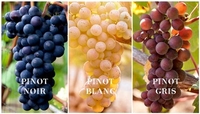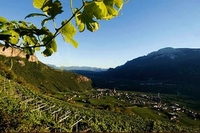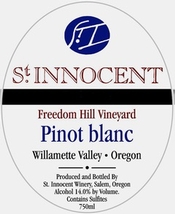The Pinot Blanc variety has long been overlooked when the discussion turns to fine wine grapes. It is, I believe, a grape of marvelous potential that has never gained much traction in the marketplace. Although some argue for an Alsace provenance, Pinot Blanc’s origin is most likely in Burgundy, where it developed as a white-berried mutation of the Pinot Noir. Given the Pinot family’s predilection for mutation, it is certainly possible that white-berried Pinot vines developed in more than one region. Pinot Gris developed similarly as a pink-berried mutation and has found enthusiastic acceptance in the world market as Pinot Grigio.

The Pinot Family from Elk Cove Vineyards
Pinot Blanc is grown under a variety names in different regions of the world. It has been called Clevner at times in Alsace as well as Epinette, Noirien Blanc, Auvernas and Gros Doré in other parts of France. Pinot Bianco is the name in Italy and Weissburgunder in Germany and Austria. In Hungary, it’s known as Fehér Burgundi and it goes by Rulandské Bílé in the Czech Republic.
In addition to its many synonyms, Pinot Blanc has a history of confusion with other varieties. It looks like Chardonnay and was known as Pinot Blanc-Chardonnet a century ago in France. Additionally, Pinot Bianco in northern Italy was often mis-identified as Chardonnay. In Alsace, the similar-appearing Auxerrois grape variety is included under the Pinot Blanc category in the vine census. Pinot Blanc was among the several incorrect synonyms of the Savagnin Blanc grape of the Jura and elsewhere. In California, many of the early plantings of supposed Pinot Blanc were Melon – the grape of Muscadet in the Loire Valley.
Pinot Blanc is now planted, albeit sparsely, in many winegrowing regions around the world. In the ranking of vineyard area of the world’s wine grapes, Pinot Blanc comes in at number 55 (13,779 ha), just behind Nero d’Avola and Touriga Franca and just ahead of the Moldovan variety Fetească Albă (Pinot Noir is #12 and Pinot Gris is #20). Given the ideal combination of soil, climate, viticultural skill and expert winemaking, the Pinot Blanc can yield some wonderfully textured, aromatic, nuanced and satisfying white wines. Sadly, these conditions are frequently not present and much of the Pinot Blanc wine made today falls far short of the grape's ultimate potential.
Pinot Blanc, when planted in an amenable soil, is a vigorous grower that can produce a large crop if not controlled. That may be why its reputation is more as a workhorse variety rather than a source of exceptional wine. When yields are naturally limited by spare soils, the potential for quality rises. Pinot Blanc is much easier to grow than Pinot Noir. It is quite cold resistant and thus is becoming popular in higher latitude growing regions. It buds early and ripens at early to mid-harvest but forms tight clusters that can succumb to fungal infections. In a few areas, botrytis cinerea, the “noble rot” of dessert wine fame can yield intriguing and powerful wines. Unfortunately, however, various forms of highly ignoble acid rot along with powdery mildew can destroy a crop without some vineyard intervention.
While it looks a lot like Chardonnay, Pinot Blanc produces a different style of wine. It is similar in that it can be manipulated in the winery to a desired style. On its own, it is full-bodied but relatively subtle when compared to Pinot Gris or Chardonnay. It offers light floral scents plus hints of peach, pear, almond and sometimes tropical fruits when very ripe. It has a full texture on the palate and pairs well with a wide range of foods, probably because its subtlety fits in rather than dominates. Some producers age Pinot Blanc in oak and, if not overdone, can craft wines with delicate vanilla and spice nuances.
Touring the world, we start in Alsace where Pinot Blanc receives its greatest recognition. Many producers have a Pinot Blanc in their lineup. The vineyard statistics can be confusing since the Auxerrois grape is counted with Pinot Blanc. The true Pinot comprises about two-thirds of the stated vineyard area. In addition to still white, Pinot Blanc is often the dominant grape in Crémant d’Alsace, a sparkling wine that is gaining popularity. Some favorite Alsace Pinot Blanc producers of mine are Lucien Albrecht ($15), Hugel “Cuvée les Amours” ($17), Marc Kreydenweiss Kritt Pinot Blanc ($20), Jean Biecher ($14), and Domaine Schlumberger Les Princes Abbés ($17).

The Vorberg Vineyard in the Alto Adige
In northern Italy, both Friuli and Alto Adige are noted regions for Pinot Bianco. Some of the most impressive Pinot Bianco wines I have sampled come from Cantina Terlano in the Alto Adige. This small cooperative winery was founded in 1893 and make a range of Pinot Bianco wines. The Tradition Pinot Bianco ($21), single-vineyard Vorberg Riserva ($45) and Pinot Bianco based blend Nova Domus Riserva ($64) are all exceptional wines. The Riservas exemplify the layering and multi-dimensional character Pinot Bianco can achieve when carefully crafted. Cantina Terlano Pinot Biancos can age beautifully as well. A recent tasting of a 1983 Pinot Bianco revealed a wine with remarkable freshness and character after three-plus decades of age.
Other Alto Adige Pinot Biancos I have enjoyed are Elena Walch Pinot Bianco ($18), Nals Margreid Sirmian Pinot Bianco ($25), Colterenzio Cora Pinot Bianco ($14) and Kettmeier Pinot Bianco ($19) among many more. In Friuli, there are exceptional Pinot Biancos in abundance. From the Colli Orientali del Friuli, the Torre Rosazza Pinot Bianco ($21) offers a layered, creamy elegance. The Vigneti Le Monde Grave del Friuli Pinot Bianco ($15) combines fresh pear, apple and tropical fruits with a rich texture. In Collio, the Villa Russiz Pinot Bianco ($21) and Schiopetto Pinot Bianco ($26) are superior renditions. In addition to these specific appellations, many wines are sold under the more generic Vigneti delle Dolomiti appellation and there are very good examples available at affordable prices.
In Germany, the Pfalz, Baden and Rheinhessen can all provide exceptional Weissburgunder wines. Topping my list is the Ökonomierat Rebholz Weisser Burgunder/Pinot Blanc ($26) grown in loess soils in the Pfalz. The very limited Rebholz Weisser Burgunder Im Sonnenschein Grosses Gewächs ($100) is a marvelously complex and textured rendition. Wagner-Stempel in the Rheinhessen crafts an excellent Weissburgunder/Pinot Blanc Siefersheim ($25) that has a delicious tropical fruit nuance. Baden wines are rare in the U.S., but the Dr. Heger and Salwey estates both produce fine Weissburgunder wines. In Austria, Pinot Blanc is most famous in the Burgenland, where it combines with other grapes to make the luscious botrytis-affected dessert wines around the Neusiedlersee.
In the United States, Pinot Blanc is planted occasionally. Chalone has produced an Estate Pinot Blanc ($28) from their eponymous AVA in Monterey county for decades. Although some of their vines are apparently Melon, the 75-year-old, original vineyard block is the true Pinot Blanc. Au Bon Climat in the Santa Maria Valley makes a Pinot Gris/Pinot Blanc blend ($18) as well as the excellent Hildegard ($35) that adds Aligoté to the Gris/Blanc mix. In Mendocino County, Navarro Pinot Blanc ($19) shows luscious fruit with a cool-climate refreshing style. The Finger Lakes of New York is also becoming a place for new Pinot Blanc plantings and we can expect to see more in vintages to come.

Pinot Blanc Label from Oregon
Pinot Blanc is perhaps making its greatest inroads in Oregon’s Willamette Valley. The cooler climate here lets the grapes develop greater flavor as they ripen slowly. St. Innocent Freedom Hill Pinot Blanc ($19) is a fine example from the western reaches of Willamette. Winters Hill in the Dundee Hills makes a Reserve Pinot Blanc ($29) that shows a deft use of oak. Elk Cove ($19), Bethel Heights ($26), Brooks ($21) all offer fine Pinot Blancs and it seems there are more producers every vintage. There is a burgeoning interest in Pinot Blanc in the Okanagan Valley of British Columbia. The grape’s cold hardiness is especially appealing in this northern clime.
A common thread throughout the world’s Pinot Blanc wines is their affordability. That, combined with their easy versatility as a food companion makes them worth an extended look. Find your favorites before they become too popular and thus difficult to acquire.